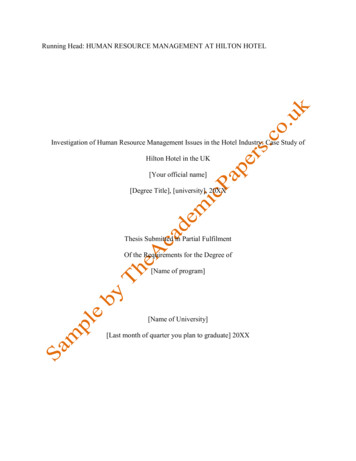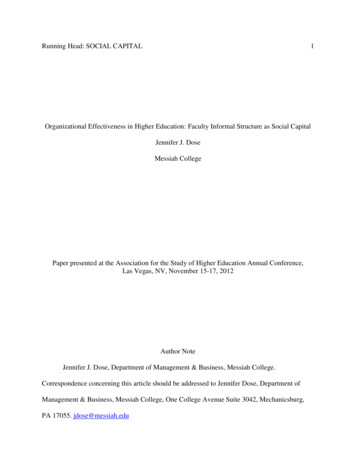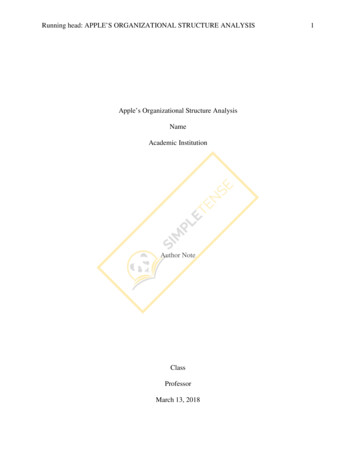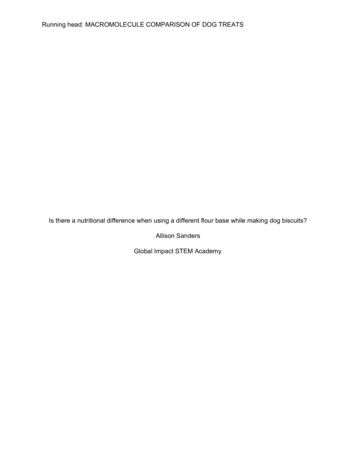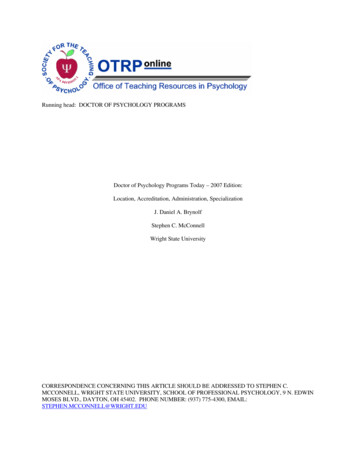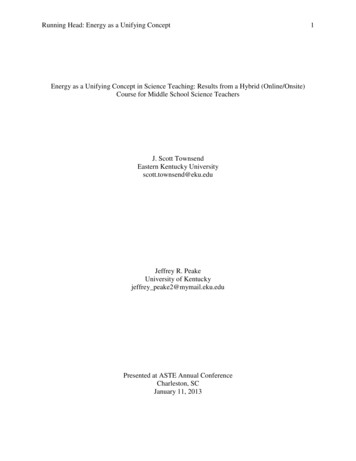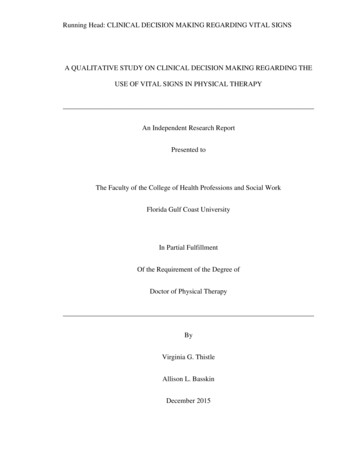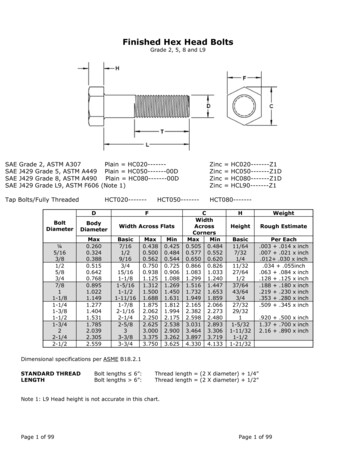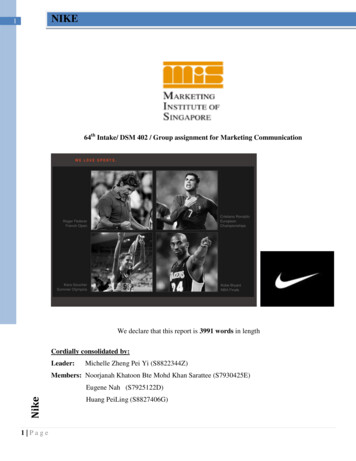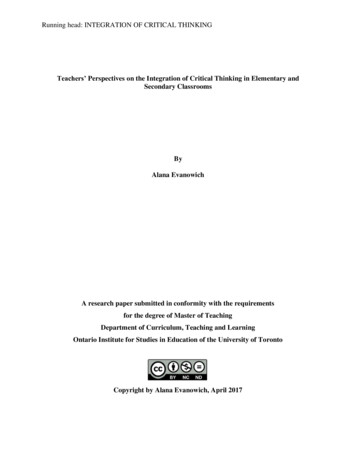
Transcription
Running head: INTEGRATION OF CRITICAL THINKINGTeachers’ Perspectives on the Integration of Critical Thinking in Elementary andSecondary ClassroomsByAlana EvanowichA research paper submitted in conformity with the requirementsfor the degree of Master of TeachingDepartment of Curriculum, Teaching and LearningOntario Institute for Studies in Education of the University of TorontoCopyright by Alana Evanowich, April 2017
INTEGRATION OF CRITICAL THINKINGiiAbstractThis qualitative study served to investigate elementary and secondary school teachers’perspectives on the use of critical thinking in the classroom. The study examines some of theeffects integrating CT can have on student learning. Three semi-structured interviews wereconducted with both elementary and secondary teachers. Through an analysis of the data, fourbroad themes emerged: classroom and school environments, teacher perceptions of criticalthinking, teacher experiences with incorporating critical thinking, and lack of student engagement.After analyzing the data, implications and recommendations were made for the educationalresearch community, as well as suggestions for future areas of research.Keywords: critical thinking, teacher experiences, teacher perceptions, student disengagement
INTEGRATION OF CRITICAL THINKINGiiiAcknowledgementsI would like to acknowledge and thank the people who supported me through the processof writing this research project. First, I would like to sincerely thank all three of my participants.Their knowledge of critical thinking and their drive as teachers was incredibly valuable to thisstudy. I would like to thank my advisors, Hilary Inwood, Ken McNeilly and Laura Landertinger.They provided valuable feedback and support throughout this entire writing process. I wish tothank my classmates, whom I could not have imagined going through this process without. Lastly,I would like to thank my family and closest friends who encouraged me to focus on what I ampassionate about, and motivated me to do this research.
INTEGRATION OF CRITICAL THINKINGivTable of ContentsAbstract . iiAcknowledgements . iiiChapter One: Introduction . 11.0 Introduction to the Research Study . 11.1 Purpose of the Study . 21.2 Research Questions . 31.3 Background of the Researcher . 31.4 Introduction to Methods . 41.5 Conclusion . 4Chapter Two: Literature Review . 62.0 Introduction to the Chapter . 62.1 Early Studies in Critical Thinking . 62.2 Why Implement Critical Thinking into the Classroom? . 82.2.1 Refutes classification of thinking. 82.2.2 Encourages thinking with judgement. 92.3 Barriers to Implementing Critical Thinking . 102.4 How to Implement Critical Thinking into the Classroom . 122.4.1 Professional development . 122.4.2 Curriculum integration . 142.5 Conclusion . 15Chapter Three: Research Methodology . 163.0 Introduction to the Chapter . 163.1 Research Approach and Procedures. 163.2 Instruments of Data Collection . 173.3 Participants . 183.3.1 Sampling criterion . 183.3.2 Participant recruitment . 183.3.3 Participant biographies. 193.4 Data Analysis . 193.5 Ethical Review Procedures . 20
INTEGRATION OF CRITICAL THINKINGv3.6 Methodological Limitations and Strengths . 223.7 Conclusion . 23Chapter Four: Research Findings. 254.0 Introduction to the Chapter . 254.1 Classroom and School Environments . 264.1.1 Support of staff . 274.1.2 Professional development . 294.2 Teacher Perceptions of Critical Thinking . 304.2.1 Teacher understanding of critical thinking . 304.3 Teacher Experiences with Incorporating Critical Thinking. 314.3.1 Student engagement . 324.3.2 Curriculum integration . 334.3.3 Assessment strategies. 354.4 Lack of Student Engagement . 364.5 Conclusion . 37Chapter Five: Implications . 395.0 Introduction to the Chapter . 395.1 Key Findings and their Significance . 395.2 Implications of Findings . 415.3 Recommendations . 425.4 Areas for Further Research . 445.5 Concluding Comments. 44References . 46Appendix A: Letter of Signed Consent . 50Appendix B: Interview Protocol . 53
INTEGRATION OF CRITICAL THINKING1Chapter One: Introduction1.0 Introduction to the Research StudyOne of the many roles teachers have today is to support young learners in becomingthoughtful, motivated members of society. Certainly, one task of educators is that of equippingstudents with knowledge to help them become excellent problem solvers.One pedagogical approach that educators can use to help prepare students for the worldoutside of the classroom is Critical Thinking (CT) (Kettler, 2014; Ontario Ministry of Education,2013). In the past, the role of a teacher has sometimes been thought of a “transmitter ofknowledge” (Swartz, 2004). Instead, moving forward, the role of the teacher is to observe howthe students learn, and help guide them through the process of engaging and interacting withinformation. Knowledge is acquired through critical engagement with information.The pedagogical concept of CT is not a new one; it has been at the fore front ofconversations about education for the past thirty years (Case, 2005). One of the main scholars inthe field of CT is Lipman (1987). A philosopher and educator, Lipman thought of CT as“thinking with criteria” (p. 5). As a professor at Columbia University, Lipman found his studentsto be under-thinking, which was incredibly problematic. To help positively change how hisstudents think, Lipman started with the youngest students in formal education, those inKindergarten. He founded Philosophy for Children (Martin, 2011) to introduce philosophicalconcepts at a young age so that students would begin to interact with their knowledge at thebeginning of their education, with the hope that this would continue. Lipman understood CT “tobe defined by three characteristics (1) it is self-corrective thinking; (2) it is thinking with criteria;and (3) it is thinking that is sensitive to context” (p.5). This definition of CT has provided areference point throughout this study.
INTEGRATION OF CRITICAL THINKING2CT is currently a major topic of conversation in the world of education. The Ministry ofEducation has just released a draft of a document that focuses on what students will need tosucceed in the 21 st century (Draft, Ministry of Education, 2016). Within this document, CT ishighlighted as one of the key skills for students to learn that indicate success. As an educationaltool it is included in numerous Ontario curriculum documents (Ontario Ministry of Education,2005; 2006; 2007; 2009; 2013; 2015; 2016). Students are being encouraged and challenged at ayounger age to think critically and independently. Young learners have the capacity to thinkcritically and should have high expectations set for them in regards to the contribution that theycan make in the world. By providing the skills to young students of how to think critically,educators can validate student learning and self-concept.1.1 Purpose of the StudyThe purpose of this study is to investigate elementary and secondary school teachers’ useof CT in the classroom. Today’s education system has evolved into one that provides tools forstudent success that they can use for the rest of their lives (Kettler, 2014). The main goal ofeducation has always been for students to attain knowledge, but now there is support thatknowledge can only be attained through CT (Paul, 1993). A recent fear of educators is that toostrong of a focus on inquiry/CT based education is leading to lower test scores because studentsare not learning ‘the basics’ (Case et al., 2015). The problem this study is interested in, is theextent to which teachers implement CT in classrooms instead of a more traditional method ofteaching the curriculum also known as “back to basics” (Case et al.). As there are currenthesitations in implementing CT, this study investigates whether or not teachers are integratingthe pedagogical approach of CT in the classroom.
INTEGRATION OF CRITICAL THINKING31.2 Research QuestionsThe goal of this study is to learn through the perspective of teachers how CT effectsstudents when it is implemented, its’ benefits to student learning, and the ways in which teachersassess CT. The study hopes to provide insight on CT for other educators through the results. Theintention is to provide insight on how to implement CT and the effects of it on the classroomenvironment and student academic success. Kettler (2014) states that the ability to critically thinkis an essential skill for everyone to have in order to be successful in life. The revised OntarioCurriculum document for Social Studies (2013) incorporates the use of CT within the “Tools andStrategies to Help Achieve the Vision of the Program,” section of the document; CT isconsidered to be an important tool within the program to become a “Responsible ActiveCitizen.” With these ideas in mind, CT is a widely-supported concept within educationalresearch that is a necessary strategy so that students will become active agents in the world at ayoung age. Therefore, this study’s main research question is: What are teachers’ perspectives onthe effects of critical thinking on elementary and secondary students’ learning? Morespecifically, the study aims
Keywords: critical thinking, teacher experiences, teacher perceptions, student disengagement . INTEGRATION OF CRITICAL THINKING iii Acknowledgements I would like to acknowledge and thank the people who supported me through the process of writing this research project. First, I would like to sincerely thank all three of my participants. Their knowledge of critical thinking and their drive as .
